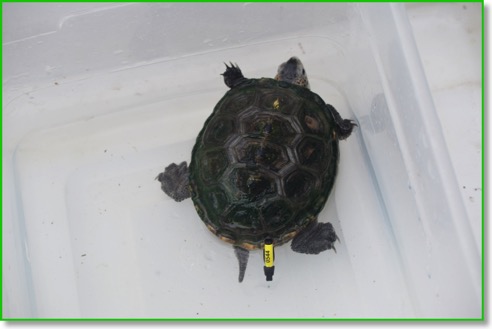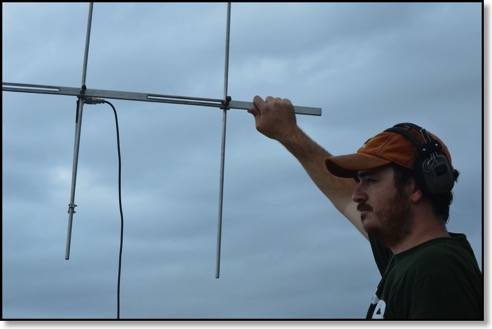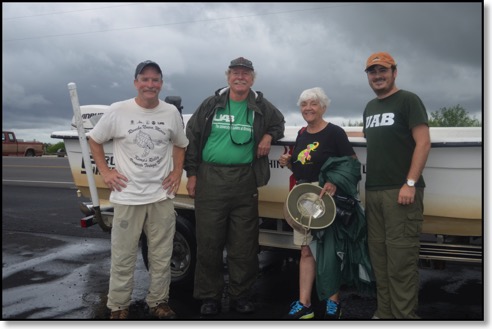YA Eco Mysteries, Memoirs, Novels & Travel
Saving Diamondback Terrapin Turtles
On a surprisingly cool morning in August, far from the lab on the UAB campus in the heart of downtown Birmingham, where they were hatched, we gently release diamondback terrapin turtles into the open marshes around Cedar Point near Dauphin Island. As if sensing that this watery, wild place is their ancestral home, the terrapins begin to explore their new habitat. Swimming between tall marsh grasses, they reach a mud island where they can begin to acclimate to life in the wild.

Diamondback Terrapin Turtle raised at UAB lab (Boris Datnow, photo)
Before releasing a terrapin, I look more closely at it. It’s a strange looking and curious creature that has been around for 220 million years, meaning they were around before dinosaurs. It’s the only turtle in North America that inhabits brackish marshes along the coast.

Along Alabama Marsh, near Dauphin Island (Boris Datnow)
“The terrapin has an incredibly rich history in Alabama,” biology professor Thane Wibbels, Ph.D, tells us. “Our state used to have thousands of terrapins. At one point, they were shipping up to 12,000 a year out of Alabama.”
Now on the brink of becoming endangered, at one time Alabama had the largest turtle farms in the world. Farms raised thousands of turtles to make delicacies like turtle soup, and turtle stew served in fancy restaurants. But that is not what destroyed the turtle population. From the late 1940s, at the site of that former farm on Cedar Point along Alabama Dauphin Island Marsh, crab trapping began to increase. Over time, hundreds of young turtles were caught in the crab traps, causing a serious decline in the turtle population. Where once the marshes were filled with turtles, only a few clusters now remain.
The development of resort and commercial property at the coast, destroyed a big slice of the terrapins’ natural habitat, in turn that was followed by an increase in the number of raccoons and other natural predators of the terrapin. By the turn of the 21st century, the diamondbacks had almost disappeared from Alabama salt marshes
Today, UAB biologists are at the forefront of efforts to protect the turtles, with the goal of keeping the diamondback terrapin off the endangered species list. Far from the coast, about 120 diamondback terrapins are now in residence on the UAB campus, all hatched from eggs that Professors Wibbels, and Ken Marion, and his doctoral students collected from Cedar Point. The turtles are part of a captive-rearing program that began in 2006 to the save them from being eaten by birds and raccoons. Thus far, they have released about 300 turtles back in the marsh.
Each turtle has a numbered tag attached to its shell, and a tag just below the skin to help track them with radio signals. After releasing the turtles, we skim through the channels bordered by a variety of tall grasses, stopping to see if the antennae can pick up signals from previously released terrapins. At one stop the signal comes in loud and clear, identifying the movements of a terrapin released in May.

Monitoring Released Diamondback Turtles (Boris Datnow)
So why all this effort to save one species? “If you remove the terrapin from the marsh the eco system becomes less stable,” Dr. Wibbles explains. These terrapins may be a keystone species—if you take them out, certain invertebrate species will proliferate, and these will eat more of the marsh grasses, causing a shift in the finely tuned eco system. The terrapins help to maintain a healthy salt marsh that is a nursery for crabs, fish, oysters, and a variety of aquatic life.
Wibbels tells us, “The point was to give these turtles a safe head start,” “We hatch and then raise them into really healthy adults that are ready for nesting.”

Professors Thane Wibbles, Ken Marion, and Graduate Student, with Claire (Boris Datnow)
As our skiff heads back through the channels cutting through the variegated marsh grasses, I relish the beauty of this special wild place. Thanks to the dedicated work and clear vision of this team of biologist who have devoted their lives to studying and conserving the rich diversity of life in the marsh, may this habitat and all the species in it continue to flourish for future generations to enjoy.
After note: This is the start of the research process I will be following for writing the sixth book in the eco mystery series, The Adventures of The Sizzling Six. I am most grateful to Dr. Wibbles and Dr. Marion for sharing their research in the field with me.
The Adventures of The Sizzling Six
Teacher Handout—How to Become and Eco Detective
WANT TO SHARE OR COMMENT? Please click on the icons(s) of your favorite social media to share, or to comment.


